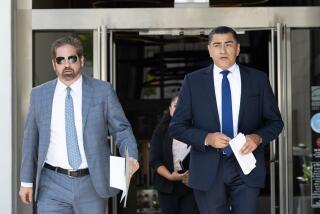Andy Anderson dead at 85; former L.A. deputy police chief
- Share via
Marshall L. “Andy” Anderson, who as a deputy chief of the Los Angeles Police Department broke ranks to criticize the fatal 1979 police shooting of Eulia Love, whose killing became a civil rights cause célèbre, died Dec. 14 at his Brentwood home. He was 85.
His death after a long illness was confirmed by his wife, Patricia Anderson.
Anderson was in charge of five South Los Angeles police divisions in 1979 when two white officers under his command shot Love, an African American woman who had threatened them with a knife during a dispute over an unpaid $22 gas bill. Love died from multiple gunshots, at least one of which hit her after she fell to the ground, a subsequent investigation showed.
FOR THE RECORD:
Marshall “Andy” Anderson: In the Dec. 22 California section, an obituary on Marshall “Andy” Anderson, an LAPD deputy chief who criticized the conduct of two officers who shot and killed Eulia Love, a black woman, in 1979, said both officers were white. One of the officers was black. —
Police Chief Daryl F. Gates defended the officers, saying they had fired in self-defense and had not violated department policies.
But Anderson, in a report made public a few months after the shooting, said the officers had used “faulty judgment and poor tactics” in approaching Love outside her South L.A. home with their guns drawn.
His assessment of the shooting was later validated by the Los Angeles Police Commission, which had previously played little if any role in investigations of officer-involved shootings. After Love’s death, the commission began to review all police shootings to determine if the use of force was justified.
In the Love case, the commission found that the 39-year-old woman had been shot unnecessarily, a conclusion Anderson had reached when he was one of three members of the department’s shooting review board. He was the only one of the three commanders on the panel to take issue with the officers’ conduct.
Noting that the officers had fired 12 shots in rapid succession, Anderson wrote that “12 seems excessive.” He also assailed the officers’ attempt to justify their actions by claiming later that they had feared Love would harm her two children, who were home at the time.
The other two commanders on the review board said the officers had handled the situation appropriately and did not merit any kind of disciplinary action. Gates backed their position and considered the case closed.
The black community was outraged by the shooting and the department’s ruling that it had been “in policy.” Protesters marched on LAPD headquarters at Parker Center.
Under pressure from the community, the police commission conducted its own months-long investigation and found “serious errors” in judgment and tactics, including the officers’ decision to draw their guns on Love “before all reasonable alternatives had been exhausted.”
After the Love shooting, the commission expanded the public reporting of police shootings, including releasing the names of officers involved in such incidents. The policy was changed again in 2006 when the commission, acting on legal advice, voted to return to the practice of withholding officers’ names.
In 1979, then-Police Commissioner Samuel L. Williams praised Anderson for “the courage to state his opinion.”
Gates appeared to echo Williams’ view, calling Anderson “a damn good chief” after reporters asked if the commander’s candor had affected his career. But Anderson left the department the following year, after 28 years on the force.
“It was a difficult time,” Patricia Anderson said in an interview this week. “He always had a strong sense of fairness … and it just didn’t make sense to him the way that case went down.”
The son of an engineer, Anderson was born in Buffalo, N.Y., on March 21, 1928.
He attended night classes at North Hollywood High School and earned a football scholarship to Rutgers University but entered the Navy instead.
After completing his military service in 1946, he studied at USC but did not earn a degree. He later received a master’s in business from Pepperdine University.
He joined the LAPD in 1950 and worked in traffic, juvenile crime and vice. By 1967 he was a lieutenant and one of the department’s first community relations officers.
After leaving the department in 1980 he headed the city Housing Authority police and helped manage security at a number of venues during the 1984 Olympic Games in Los Angeles.
He also worked with former LAPD Chief Tom Reddin in a private security consulting business.
Besides his wife, he is survived by four children, Donna Mays of Denver, Michael Anderson of Gig Harbor, Wash., Liane Jacob of Sherman Oaks and Victoria Reiser of Irvine; eight grandchildren and four great-grandchildren.
More to Read
Start your day right
Sign up for Essential California for the L.A. Times biggest news, features and recommendations in your inbox six days a week.
You may occasionally receive promotional content from the Los Angeles Times.







